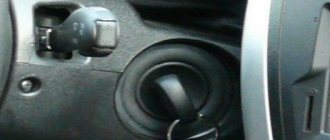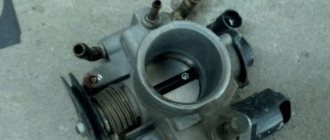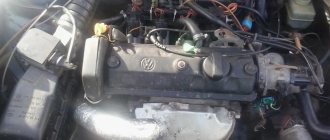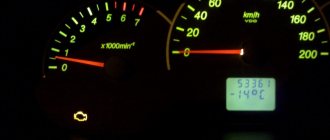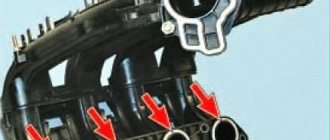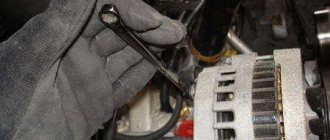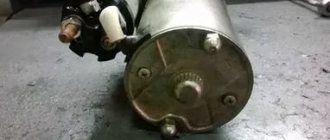Every car owner sooner or later encounters various car troubles, and Lada Priora owners are no exception. Various problems occur, including when it is difficult to start when cold. There are many reasons for such problems when starting a car is difficult. In this material we will analyze in detail the reasons when a car does not start, as well as when it troits and stalls when cold.
Main types of “bad” launch
Typically, experienced drivers immediately assess the malfunction in the following way: “Poor hot start.” That is, it is clear that there are 3 types of bad startup:
- Poor cold starting.
- It starts poorly when the engine is hot.
- Doesn't start well in any condition.
This means that these three types have their own characteristics, although they are united by one sign - the car is difficult to start. But in the first case, this only happens when the car has cooled down. Either this is the first start in the morning, or the Priora has been sitting long enough for the engine to cool down completely, or it is a harsh winter.
In the second case, the Priora does not start immediately, but only after several full turns of the crankshaft with the starter only when the engine temperature is above 90 degrees. That is, a fully warmed up engine. Usually after some mileage.
Well, the third option is when Priora is capricious in any conditions. Be it in the morning, at lunch or in the evening, on a cold or hot engine. Here we will consider the minimum possibilities that the owner has to solve this problem on his own.
Why doesn't the engine rev up? Possible causes and methods of eliminating them
The engine does not pick up speed when you press the gas pedal: reasons
First of all, you need to pay attention to the “symptoms” of the problem: when it manifests itself, how, and whether there are additional signals indicating a malfunction. It is quite possible that the engine is fully operational and is being prevented from functioning normally by a sensor that was disconnected during repairs.
The technician can fix this problem after a short inspection.
If engine failures occur without any serious reasons, careful diagnostics are required.
Let's take a closer look at the reasons that the car owner can correct himself.
A key factor in reliable engine operation is the quality of the fuel mixture, the characteristics of its flow, ignition and combustion in the working area of the engine. Violation of any of the above processes leads to problems with engine speed
That is why, in case of failures in the internal combustion engine, the first thing you should pay attention to is the operation of the fuel and oxygen supply system
- If dirt, a mixture of oil and sand has accumulated in the air filter, air will penetrate into the engine unevenly, which will lead to a loss of engine power and, accordingly, to “missed” revolutions.
2. Malfunction of the intake system leads to excessive air leaks. The failure may occur suddenly, or it may become chronic. The intake of a large amount of air depletes the mixture, and there are too few flammable vapors in it. In this case, the engine starts, but during the trip the car cannot reach the required speed.
5.
6.
Correcting these problems is not difficult: you need to check whether the spark plugs and wires are sparking; look at the pressure level on the fuel rail pressure gauge; remove oily deposits and dirt from the air filter; change the fuel filter to a new one; clean the fuel pump screen, etc. from dirt deposits.
Engine speed may also drop for more complex reasons, which cannot be eliminated on your own, since repairs require special knowledge, experience and the availability of diagnostic equipment.
You cannot do without the help of a car service if:
- Failure in the timing of the car's gas distribution mechanism. If the timing of the engine is disrupted, the fuel intake and exhaust gases are uneven, and the valves open intermittently. A similar problem often arises after poor-quality repairs such as replacing the timing belt, improper valve adjustment, malfunctions of the valve timing system, and failure of the timing chain.
- Malfunction of the coils or ignition module. The main “sign” of this problem is that the engine begins to stall, misfires are observed in the cylinder system, and the number of revolutions decreases.
- Malfunctions in the power supply of the injector nozzles. The most common cause of this problem is poor wiring. The electrical signal does not reach the injector or does not reach it at the right time. Naturally, under such conditions, the injector cannot work correctly, which is why the fuel ignites unevenly in the cylinders, and engine power drops along with the speed.
- Problems with the fuel pump. An unpleasant breakdown that develops slowly but inevitably. As a result, the pressure created will not be enough to operate the engine: the engine will stall.
- Dirt getting into the injector. This problem can be caused by the use of low-quality fuel and contamination of the injectors. It is recommended to clean the injectors after 35-45 thousand km. mileage
- Unsatisfactory condition of the systems responsible for the removal of gases, primarily the USR, soot filters and catalyst. A large amount of carbon dioxide remains in the engine and the engine is not able to gain the required number of revolutions under such conditions.
- Failure of the electronic control system devices of the internal combustion engine, leading to a change in the composition of the combustible mixture.
- A breakdown of the electronic control unit cannot be ruled out. This problem can occur after poor-quality firmware repair. The main signal of a problem in the ECU is the jerky operation of the engine, an unexpected increase and drop in torque.
For a gas car, the correct settings of the engine and fuel supply system are key.
Hot
So, the car drove some distance. In the morning it started up with a half-turn, and forward. But then some distance was covered, a stop was made, the key was turned to “start” and... Several painful revolutions, and only then the engine started working. What's happened? As a rule, there can be many reasons. Conventionally, they can be divided into groups:
- The fuel system is acting up.
- Errors or breakdowns of sensors or actuators of the control system.
- Engine wear.
The first step is to check the presence of fuel in the injector frame. Gasoline supply is the most likely cause of problems. To do this, you need to open the hood and remove the decorative trim from the engine. The intake manifold runs between the engine and the Priora radiator. Below it is a fuel frame. At the end there is a special bypass valve, closed with a plastic cap. You need to unscrew it and press on the core. A strong release of fuel should occur.
When connecting this device, you need to turn on the ignition without trying to start it. The pressure must be at least 2.6. There is another option. Not so reliable, but quite usable. Perform the download several times before starting if the Priora is difficult to start. That is, without turning on the starter, wait until the fuel pump turns off, turn off the ignition and turn it on again without the starter. Do this several times. And then turn the engine. If starting improves, it means there was not enough pressure and you need to check the filters and fuel pump.
And another reason related to the fuel system is the banal clogging of the injectors, which gives the effect of poor starting to the same extent. But this is just a specialist checking the entire fuel frame at a special stand.
Electronic part of the check
Here it is worth clarifying immediately. There can be no talk of any complete determination of the cause of a poor startup without computer diagnostics. Although several positions can be checked. The easiest way is to check the performance of the Priora cylinders. To do this, you need to remove the decorative cover, start the engine and leave it at idle. Let it work a little and try to remove the connectors from the ignition modules one by one.
This requires good hearing and attentiveness. It is necessary to clearly determine which of the cylinders, when switched off, the operating rhythm changes the least.
If the Lada Priora's starter does not turn
| Possible malfunction | Diagnostics | Remedies |
| Low battery | The voltage at the battery terminals without load is less than 12V. When trying to start the engine, a cracking noise is heard from under the hood. | Charge the battery or replace it with a new one |
| Oxidation of battery terminals or wire terminals, their fit is not tight | When you try to start the car, the voltage in the on-board network drops much more than at the battery terminals. In this case, a crash may be heard under the hood. | Clean the contacts, lubricate them with petroleum jelly and tighten the terminals |
| The engine or attachments are jammed | Check the rotation of the crankshaft, pump and generator pulley. | Repair engine, generator, pump |
| The starter is faulty, the starter drive gear or flywheel ring teeth are damaged | Remove and inspect the starter. | Repair or replace starter |
| The starter switching circuit or starter relay is faulty, the wires are damaged, or the ignition switch contacts do not close | When the key is turned to position “II”, the starter traction relay does not operate (a click is not heard under the hood). Check the +12V supply to the control contact of the traction relay. | Replace starter relay, wires, ignition switch |
| The starter traction relay is faulty, there is a short circuit or break in the retractor winding, the relay armature is stuck | When the key is turned to position “II”, the traction relay does not operate (there is no click under the hood), but + 12V is supplied to the control contact of the traction relay. Remove the relay and check its operation. | Replace the traction relay |
| Contacts or wires of the traction relay are oxidized, poor ground contact | When the starter is turned on, a clicking sound is heard under the hood, but the starter armature does not rotate. Using an ohmmeter, check the resistance of the Battery-Starter circuit, as well as the ground wire. If the circuit is in good condition, remove the starter and check the operation of the traction relay by applying +12V to it from the battery | Tighten the terminals, clean the contacts, replace the traction relay |
| Open or short circuit in the holding winding of the traction relay | When you try to start the engine, you hear a crashing sound under the hood. The battery voltage is within normal limits. We check the traction relay with an ohmmeter or by its excessive heating. | Replace the traction relay |
| Burnt starter commutator, stuck brushes or severe wear Open or short circuit in the starter armature winding | The starter armature rotates slowly or does not rotate at all. Check the traction relay by applying voltage to the starter contact bolt directly from the battery | Replace starter or armature |
| Freewheel slipping | When the starter is turned on, the armature rotates, the flywheel is stationary | Replace clutch or starter |
In the cold
Morning, key to start. The starter cranks the engine, but the Priora does not start right away. Where to start? In general, most of the reasons are the same as for a bad hot start. The only difference between the second option is that here, failure in the electronic part is more common. That is, the sensors and actuators of the Priora are acting up. By the way, launching Priora in cold weather is a separate topic. Although cars with distributed injection themselves tolerate frost much better than carburetor cars. While with a “hot start”, more often the problem is in the fuel system. At the same time, if the Priora does not start well in any condition, then most often it is engine wear.
But we definitely need to remind you that the most reliable testing method for Priora is computer diagnostics. The methods described here, of course, will help an experienced driver find and fix a minor breakdown, but only diagnostics will reveal a specific malfunction.
Automotive diagnostic equipment
- List of forums ‹ Diagnostics ‹ Diagnostics of domestic cars
- Change font size
- For print
- RSS
- FAQ
- Registration
- Entrance
The engine starts only when you press the gas pedal, what is the reason?
- To the beginning of the forum
- Forum Rules
- Old design
- FAQ
- Search
- Users
Epilogue.
I came to work today by public transport.
Prologue.
I wake up and look out the window. Brr.. Light drizzle, temperature +4. In short dashes I get to the garage (fortunately it’s not far away) and there it is - my car (eng. 99, 2002, 47,000 km). In accordance with the Talmud on the operation of this miracle, I install a gasket between the steering wheel and the seat directly on the seat. I disarm the APS-4. Key to start. I'm waiting for the fuel pump to finish working. I'm getting excited. The battery revs the engine vigorously, but the engine does not engage at all (well, as if the APS or signaling system is in security mode). Okay, I think if you don’t want to start it according to the instructions, let’s go from the other side. This is followed by three unsuccessful (see Epilogue) attempts to start.
Attempt ?1. I lightly press the gas pedal, start it and... The car starts with half a turn (as always). I hold the idle speed at 2000-2500 for 10 seconds and then release the gas pedal. The car stalls the same way it started - with half a turn (without jerking, farting, etc.)
Attempt 2. (several times) I also start easily using the gas pedal, and then after 10-15 seconds I start to slowly release the pedal. The result is the same - the car stalls (almost immediately).
Attempt ?3. Using the above tricks I get started. Using the gas pedal, maintaining the speed at 2500-3000, I bring the engine temperature to 45 degrees (according to MK) and just as smoothly release the pedal. I'm going deaf.
Everything is a finita la comedy! I'm late for work. Thus, when the gas pedal is pressed, everything starts and works; when you release it, it immediately stalls.
While I was traveling by minibus and metro, writing this post, I thought that the IAC or TPS could be to blame. Any other opinions?
Source
Priora, bad morning start. (solved)
Priora, bad morning start. (solved)
nail1960 » 02 Aug 2014, 22:14 | Message: #1
Re: A373DA02 M73 21126-1411020-11 21126 E-3
sergeyelektri » 03 Aug 2014, 00:33 | Message: #2
Re: A373DA02 M73 21126-1411020-11 21126 E-3
nail1960 » 03 Aug 2014, 01:10 | Message: #3
Re: A373DA02 M73 21126-1411020-11 21126 E-3
jazz » 03 Aug 2014, 05:44 | Message: #4
Re: A373DA02 M73 21126-1411020-11 21126 E-3
Mikhail58 » 03 Aug 2014, 09:59 | Message: #5
Re: Priora, bad morning start.
nail1960 » 03 Aug 2014, 11:47 | Message: #6
Re: Priora, bad morning start.
kisel65 » Aug 03, 2014 12:25 pm | Message: #7
Re: Priora, bad morning start.
nail1960 » 03 Aug 2014, 13:02 | Message: #8
Re: Priora, bad morning start.
Serg57i » 03 Aug 2014, 16:02 | Message: #9
Nail, hello. I read this phrase and was reminded of my favorite movie “National Security Agent”. There, too, the syncopation in the bass in the third measure was delayed. Joke. No offense. As a matter of fact, I am also inclined to incontinence of the injectors. There was a similar case with ten, but they didn’t let me finish the job. I’m just aware of the result that others achieved. After all, they urgently and immediately need to issue a decision and don’t care about the specifics of the creative process. One of my former bosses, who was especially impatient, told me as an engineer: “Think fast!”
The engine stops while running - reasons
1. Poor quality fuel is the first thing that comes to mind for most of us, and besides, this is where we need to start looking for the reason for the engine stopping while driving. You will be “lucky” if this happens immediately after refueling, in which case you can confidently say that the problem is in the fuel. Treated by draining the fuel and replacing the fuel filter.
2. Candles. As a rule, suspicion most often falls on them, after bad fuel, of course. Everything is simple here - unscrew the spark plugs and check their condition, replace the spark plugs if necessary.
3. Fuel filter. A seriously clogged filter can cause an interruption in fuel supply, causing you to rev the gas and the engine to stall while driving. To eliminate the problem, simply replace the fuel filter.
Main reasons
It is very difficult to immediately find out why the engine refuses to start when it is cold. There can be two options here - either there is no spark, or there is no fuel. But if you look deeper, you can identify other problems. Let's look at the most basic reasons for cold starting of the Lada Priora engine.
Experts identify the following problems. These are low quality fuel, clogged injectors, clogged fine fuel filter, malfunction of the fuel pump, incorrect pressure adjustment in the fuel rail, clogged air filter, dirty throttle valve, clogged idle valve and low ambient temperatures during engine starting. Also, the Priora has difficulty starting when cold due to faults with the mass air flow sensor and temperature sensor.
Why is it stupid? Basic faults
Type of VAZ-2112 engine
There are not many reasons for the effect when the 16-valve engine on the VAZ-2112 16 valves stalls. Of course, you will have to tinker a little in order to find the true reason in one case or another, but otherwise there is a direct road to a car service center. For those who have decided to repair their car themselves, this information will be useful.
So, let's look at the main reasons for this effect:
We clean the sensor from dirt and dismantle it.
The main reasons are considered, and you can move on to solving these problems.
Methods for solving the problem
To eliminate failure during overclocking, you need to check all the components listed below step by step. This is a considerable amount of work, but the car enthusiast will be able to save a sufficient amount of money, which would have been charged to him at a car service center. Of course, for those who don’t understand the design of a car, that’s the way to go, or ask your friends who will fix the problems for half the price. But, if you follow the instructions, you can figure it out yourself.
Poor quality fuel
Poor quality fuel is a common cause of engine breakdowns
Of course, in our country, low-quality fuel causes many misfortunes and troubles for motorists. It is not possible to check the fuel at a gas station, so everyone is already struggling with the consequences. The only thing that can be done is to carry out regular diagnostics and cleaning of the fuel system.
Fuel system
Injectors on the fuel rail removed from the engine
The first line of engine protection is fuel filters, which sometimes fail and not enough fuel gets into the engine. On the other hand, when completely clogged, the injectors are clogged, which at low speeds give a normal amount of mixture, but if the engine is accelerated, the amount of mixture remains the same and a failure appears at low speeds.
The way out of the situation is to replace the fuel filter, clean or replace the gasoline pump mesh, and diagnose and replace failed injectors. The latter usually go through a cleaning stage, but this does not always help and they have to be replaced.
Throttle valve
Cleaned throttle body
A stuck throttle valve and insufficient air supply can cause the engine to become sluggish when accelerating. This is due to a non-optimal fuel mixture. In this case, the solution to the problem is cleaning.
Low quality fuel
At domestic gas stations, low-quality fuel is by no means uncommon. But even at branded gas stations you can buy low quality gasoline. As a result, the car will be difficult to start. The car will leave the gas station on the remaining old gasoline, and the engine will be warmed up. But after being idle, it will be quite difficult to start the car. There are several types of low-quality gasoline.
Fuel may be dirty: it may contain various deposits. They clog the fuel channels as well as the filters. As a result, the pressure in the fuel rail will be insufficient, and it will be very difficult to start the engine.
Gasoline can also be low octane. Most often, with such fuel, the car may not start when cold even the third time. You will hear the noise the engine is making, you will feel weak thrust, and detonation will occur. Experts do not recommend starting a car on this fuel.
To eliminate the cause, it is enough to drain the bad fuel and then flush the fuel system. Then you need to fill the tank with good gasoline.
How to Avoid Failures
Having talked about how to eliminate gas pedal failures that occur on a car, it is worth talking about how to completely avoid their occurrence. So, the most common cause of their occurrence is wear of the spark plugs. Therefore, you should always check their condition, prevent clogging and oxidation, and, if necessary, replace them.
In addition to spark plugs, high-voltage wires should also be periodically monitored (despite the fact that they have a long service life, core breaks and breakdowns of protection are far from uncommon).
Another very common cause is clogged filters, and especially the air filter. This element is a direct participant in the chain of formation of the working mixture, and that is why its contamination (or even damage) can immediately affect the operation of the engine.
Gasoline for VAZ 2114
The last thing you should pay attention to in order to avoid unpleasant gas failures is the quality of the fuel. If you notice that at the nearest gas station it has dropped significantly (and the car reacts to this), then you should not continue to use it - it is better to try to refuel at a pump of another company (or several companies)
In this way, you can find the highest quality gas station and ensure reliable operation of your car’s engine.
Fuel pump
This is one of the popular reasons why Priora has difficulty starting when cold. This is due to a malfunction in the fuel pump. You can even hear the sound of the node operating. But if the pump is faulty, the fuel system will not have the pressure necessary for normal operation. There is no pressure in the fuel rail, which means that starting will be poor, or the engine will not start at all.
The fuel pump can only be checked using your ears. You need to turn on the ignition of the Lada Priora. At the same time, if the fuel pump is working, a characteristic buzzing sound will be heard from the side of the tank. It will only last a few seconds. When a sufficient amount of gasoline is pumped into the ramp and the pressure becomes normal, then the pump will turn off. If there is no buzzing sound after turning on the ignition, it is recommended to replace the fuel pump.
VAZ 2110 troits engine
Engine problems, even episodic ones, always need to be addressed immediately. For example, it happens that at times the engine of a VAZ 2110 stalls, and many do not pay attention to this, continuing to operate the car as if nothing had happened. But this is the wrong attitude to this problem. Let’s look at the causes of this symptom and consider ways to quickly eliminate them.
When is it time to check the engine?
The engine should always run like a clock, that is, smoothly and without jerking, failures, or jumps.
At idle speed it is easy to notice that the engine is unstable. When such suspicions creep in, it is better to raise the hood and listen to the beats in all cylinders. “Troit” means one or two cylinders are inactive, since there are no conditions necessary to ensure the processes in their combustion chambers. As a result, the actual power of the power unit drops noticeably and gasoline consumption increases. There is also a tendency to stall, for example at intersections, at traffic lights or while warming up. At the same time, when the engine of a VAZ 2110 fails, the reasons for such a malfunction can be different. You can find out which cylinder has problems in one simple and long-known way. With the engine running, you need to remove the high-voltage wire from each spark plug one by one. If the cylinder was working properly before, then when it is turned off there will be a noticeable dip and a drop in speed (look at the tachometer scale). If there are no changes after removing the wire from the spark plug, we can safely assume that the problem is precisely in this cylinder - it was not working before the shutdown.
Causes of unstable motor operation
Here is an approximate and incomplete list of reasons for the “ten” engine tripping:
VAZ 2110 troits engine
- spark plug malfunction, getting wet;
- breakdown of a high-voltage wire;
- extremely low quality gasoline;
- air leaks in the vacuum brake booster system;
- loss of tightness in the area of the intake manifold;
- need for valve adjustment;
- valve or piston burnout;
- development of valve levers;
- breakage of piston rings;
- cylinder head gasket breakdown;
- deterioration or unsuitability of valve stem seals.
We will not dwell on all the points one by one, but it makes sense to note some methods for quickly identifying easily repairable breakdowns. So, for example, a non-working candle becomes an elementary problem. The same applies to broken armored wires. The easiest way to identify a malfunction is to replace each of these elements one by one with a known working one. It is also sometimes possible to notice sparking in the dark, which will indicate to you a damaged high-voltage wire.
There can be plenty of discussion about problems with valves, because such a “disease” is very typical for VAZ engines. First of all, we must not forget that every 10-20 thousand km the valves must be adjusted so that they are completely closed or opened during operation. But infrequent cases of valve and even piston burnout require accurate measurements of compression in the cylinders and subsequent opening of the power unit. In this case, the wear and tear of the piston rings is determined by pouring a small amount of engine oil into the cylinder - if the compression has increased, then the problem is most likely in the rings.
Throttle valve
A dirty throttle body could very well be the cause. The Priora has difficulty starting when cold due to the supply of not clean air through the damper, but with various deposits. All this can prevent the preparation of a normal mixture in the correct proportions.
Sometimes the throttle valve can even get stuck due to the huge amount of deposits on it. To solve the problem, experts recommend cleaning the throttle - you can do this yourself using an injector cleaning spray.
Inspection of high voltage wire
Often, the Priora stalls when accelerating due to a malfunction of the ignition system. This is especially true for the condition of the high-voltage wire leading to the spark plug. To inspect it, you will need to remove the tip attached to the spark plug. The structure of a high-voltage wire is as follows: the winding contains the central core of the wire. The tip, which is put on the candle, has a persistent metal penny. The main purpose of this element is to transmit current to the spark plug.
The core of the high-voltage wire should fit as tightly as possible to the “penny” of the steel tip placed on the spark plug. Due to aging, contact between this element and the wire may be lost due to oxidation of the metal. As a result, tripling occurs. The oxidation of the contact is checked as follows: with the second probe of the multimeter, you should touch the central core of the high-voltage wire; if the core of the high-voltage wire burns out along its entire length, then it is possible to identify such a section using a special multimeter tip.
The wire is pierced until the affected area is identified every 5-10 mm. If such a section is detected, it is cut off if the length of the high-voltage wire allows it. Otherwise, it needs to be replaced.
Ignition system
This is another fairly common option and the reason why the Priora has difficulty starting when cold. Almost regularly, due to sudden and constant temperature changes, various microcracks form in the ignition coils. When the coil heats up, it tends to expand. If there are cracks between the walls of the coil, then there is no hot breakdown, since the gap in the crack will be minimal. When it is cold, the microcrack will be larger and as a result there will be a breakdown. There will be no spark on the spark plug. There is no ignition of the mixture, the car does not start well.
The problem exists not only with the ignition coils, but with any other components that operate in the Priora ignition system. This could be a distributor, wires, spark plugs. In this case, there is nothing better than replacing the coil and other elements.
The engine starts only when you press the gas pedal, what is the reason?
- To the beginning of the forum
- Forum Rules
- Old design
- FAQ
- Search
- Users
In general, the 21102 plant only had a pedal, as on a carb, at first it started in the minus only with gas, now in general I always had an injector with only gas
, he seemed like a smart guy, he helped out many times. He said that all the sensors are normal. generally help out. what the hell could this be?
The spark plugs are new, the fuel pressure is checked, everything is ok. It works when it starts smoothly and clearly.
In general, the 21102 plant only has a pedal, as on a carb, at first it started in minus only with gas, now it’s generally always only with gas
I visited the injector guy, he seemed like a smart guy, he helped me out many times. He said that all the sensors are normal. generally help out. what the hell could this be?
The spark plugs are new, the fuel pressure is checked, everything is ok. It works when it starts smoothly and clearly.
In general, the 21102 plant only has a pedal, as on a carb, at first it started in minus only with gas, now it’s generally always only with gas
I visited the injector guy, he seemed like a smart guy, he helped me out many times. He said that all the sensors are normal. generally help out. what the hell could this be?
The spark plugs are new, the fuel pressure is checked, everything is ok. It works when it starts smoothly and clearly.
They changed the IAC for me. I’m telling you that the diagnostics showed everything ok including fuel pressure.
But I definitely won’t remove the injectors myself. Then it’s easier to buy a repair kit.
I'll probably go wash it
but the question is this: what if everything remains the same?
It won’t start when it’s hot because the mixture is “rich” (similar to how to start a hot car on a classic with suction). More air comes in with the gas and it seizes. If the IAC is working properly, it may be “rich” due to one of the injectors hanging in the open position. The pressure is released through it, the spraying of all nozzles decreases, the candles get wet. For the same reason, it may not start when cold.
_________________ I’m not WEAK-willed, I’m STRONGLY lazy.
[quote=”Dozen”]Starting with the pedal pressed and further refusal to work without the pedal pressed is a characteristic sign of lack of air. This may be not only due to a faulty IAC, but also due to contamination of the throttle pipe as a whole and the additional air channel (through which the IAC supplies air), due to the almost complete absence of thermal clearance of the throttle valve.
Explain, please, lack or excess of air??
Explain, please, lack or excess of air??
_________________ I’m not WEAK-willed, I’m STRONGLY lazy.
Explain, please, lack or excess of air??
Anatoly! Another question, please - is it possible to replace the IAC on your own? Any settings required?
Respectfully yours, Pavel
_________________ I’m not WEAK-willed, I’m STRONGLY lazy.
It is worth looking at the coolant temperature sensor, if it shows more than 5 degrees, it will either over-deplete the temperature higher than the actual one, or over-enrich the temperature it shows below the actual one. The effect increases with decreasing temperature
In general, the 21102 plant only has a pedal, as on a carb, at first it started in minus only with gas, now it’s generally always only with gas
I visited the injector guy, he seemed like a smart guy, he helped me out many times. He said that all the sensors are normal. generally help out. what the hell could this be?
The spark plugs are new, the fuel pressure is checked, everything is ok. It works when it starts smoothly and clearly.
Source
Low battery charge
If the Priora has an old battery installed, then in cold weather it discharges faster. This means that starting a cold engine in the morning can be problematic. Sometimes even a new battery drains quickly. In this case, you should look for current leaks. It may be in the wiring or the leak is occurring in some device.
If the search for current leakage does not produce results, then it is recommended to check how the generator charges the battery. If the charge is insufficient, then the battery will not charge fully. As a result, the starter will turn much harder than if the engine was cold.
Common causes of floating revolutions
So, we figured out the main symptoms. Now let's move on to the reasons. Let us immediately note that floating idle speed is often a problem with injection engines. The fact is that a complex ECM system is responsible for idling in this case.
This system assumes the presence of a controller, sensors and actuators. The control unit receives signals from sensors and transmits commands to actuators (for example, IAC), maintaining stable engine speeds at idle and other modes, regardless of the load on the internal combustion engine.
Article on the topic: Disadvantages of the DSG gearbox: what you need to know
However, any failures that are associated with the supply of air, fuel, a violation of the composition of the working fuel-air mixture or its ignition, as well as various mechanical breakdowns will lead to floating speed.
It turns out that you should start checking with the throttle assembly, sensors and actuators. The ignition system, idle air regulator, mass air flow sensor also need diagnostics; it is necessary to assess the condition of the fuel and air filters, injection nozzles, etc.
As a rule, in practice, the idle air regulator causes a lot of problems for drivers. In fact, this is a stepper motor that has a conical locking needle. When the throttle valve is closed, air bypasses the valve through a channel that is closed by the needle.
If malfunctions occur in the operation of the device, the ECU is not able to correctly “select” the mixture composition at idle, as a result, the speed floats.
The mass air flow sensor also deserves special attention. During operation, the air flow sensor may become dirty or break down.
One way or another, the ECU does not receive correct data on air flow, which leads to disruption of mixture formation and jumps in engine speed.
Often, a floating engine speed can be associated with severe contamination of the throttle valve itself or mechanical breakdowns of the throttle, damage, or deformation. The damper may jam and not close completely.
To prevent such complications, it is necessary to periodically clean the throttle from dirt, and on many cars, additional training of the throttle is required after cleaning.
During diagnostics, you should also check the crankcase ventilation valves. Normally, crankcase gases are redirected to the intake, where they are mixed with air and fuel, after which they are burned in the cylinders.
On engines with mileage, a lot of crankcase gases accumulate due to natural wear and tear of the CPG. An excessive amount of such gases leads to a violation of the composition of the mixture if the crankcase ventilation valve jams. This is also a common reason why engine speed fluctuates.
By the way, if you touch on carburetor engines, the speed on the carburetor floats, usually due to the settings and adjustments of this device being messed up. Also, one should not exclude the possibility of a breakdown of the carburetor solenoid valve or clogging of the idle jet.
Let’s also add that if the speed of a diesel engine fluctuates, this is often caused by rust on the fuel injection pump blades. Corrosion occurs due to the presence of water in diesel fuel.
Idle speed sensor
This is also a common problem when the Priora 16 valves have difficulty starting when cold. This sensor is an electromagnet and a rod. When the car is cold, the temperature sensor reports this to the control unit and it sends a signal to the sensor responsible for idling. The engine speed will be increased until it warms up. The sensor rod extends and the throttle opens slightly. When the engine warms up, the ECU reports this to the sensor. The rod slowly moves back.
If there is a malfunction with the idle speed sensor, the rod does not extend, and accordingly, the throttle does not open slightly or does not open completely. The sensor may be dirty, or the coil located inside the IAC may fail.
A worn-out engine causes poor car starting
This phenomenon is very rare. In general, Priora power units are quite durable when used properly. Engine wear can be determined by high oil consumption and dark exhaust from the corresponding pipe.
A competent motor mechanic can help you figure this out and also measure the compression.
Poor engine starting due to the crankshaft position sensor
This sensor is a device that sends a signal to start, and when it fails, the car will not start at all. But even here there are some nuances. It happens that dirt accumulates on the sensor, it can also accumulate on the damper, and then starting will not occur the first time. You can check this yourself. The device is located on the oil pump housing on the left side of the toothed pulley. If the engine does not start well, visually inspect the device; if there really is dirt there, then it needs to be removed.
Electric power steering Priora
Priora fog lights
Compression
If the 16-valve Priora has difficulty starting when cold, and all the options described above are not suitable, then it is worth checking the compression. In this case, with low compression, starting a cold engine can be very difficult.
When engine parts are warm enough, they expand. Even a slight expansion will be enough for the compression to rise and the engine to start. If the engine is cold, there is no expansion. Therefore, starting will be difficult.
Checking the flow meter and XX regulator
The speed fluctuates on a cold engine, which means we start the diagnosis by checking the mass air flow sensor. The reasons indicating its malfunction immediately make themselves felt: floating operation of a cold engine and its interruptions, the engine is very difficult to start or does not start at all, as well as significant excess fuel consumption. In order to verify that the sensor is faulty, we will use a tester. The working sensor will show a value of about 1 V. Otherwise, it will need to be replaced.
One of the main reasons causing the engine to float is a breakdown of the engine idle control. This regulator is capable of reducing, or vice versa, increasing the amount of fuel supplied, which is regulated by the operation of a rod with a special needle.
To the main faults
regulators include:
- unstable operation of a cold engine in idle mode;
- unexpected engine shutdown in neutral;
- change in speed even when the engine is warm;
- There is no increase in power after starting the engine.
Power drop
, or rather, engine speed, can be observed during the operation of some consumers, for example, headlights. If these signs are present, the regulator must be replaced.
Oil
Many car owners try to change their oil before winter. But not everyone knows that the oil with the lowest viscosity is best suited for winter. Thick oil will simply harden in winter. In addition, when the engine is cold, it is very difficult for it to drive thick oil through the channels. If the picture is complemented by an old battery, then this aggravates the situation even more. Therefore, you need to try to purchase oil of exactly the viscosity at which the engine can start normally even in cold weather. Typically, a product with a viscosity of 5W30 is purchased. But in any case, you need to look at the manufacturer's recommendations. You should not deviate significantly from the tolerances.
What else can cause malfunctions?
The module and spark plugs, as well as damaged high-voltage wires, can also cause unstable speed of a cold engine. Spark plugs must be changed after 25,000. km. mileage
At the same time, periodically checking them for functionality is also important. If the spark plugs are full of carbon deposits, or they are wet from fuel or oil, they also need to be replaced. To replace spark plugs, you need to get a special spark plug wrench.
Malfunctions of high-voltage wires include the reasons why electric current does not flow to the spark plugs. This can be caused by a break in the wire, if the integrity of the insulation is violated, which causes a breakdown of the current, too high resistance of the wires, as well as extremely poor operation of the contact group.
Starts and stalls
It also happens that the Priora has difficulty starting when cold and stalls. First of all, experts attribute this to the fact that little fuel is supplied to the combustion chambers, and with it cold air, which interferes with the normal ignition of the fuel mixture.
This problem can be fixed. To do this, you need to insert the ignition key into the lock to start the fuel pump. The ignition is turned off and then turned again to start the pump. When the pump is turned off, you can proceed to start the car.
The second solution to this problem is to check and try to stabilize the pressure in the fuel system. They also check the fuel filter and adjust the throttle clearance. Next, check the spark plugs and wires.
Conclusion
If your car has floating idle speed, you must:
- Remember if you have recently refueled at low-quality gas stations.
- Check the system for air leaks.
- Check all sensors that are involved in the formation of the fuel mixture.
- Check the fuel pressure in the system.
All these tips will help you independently find the cause of a breakdown in your car and fix it without much expense.
We hope our article was useful to you.
Why does the starter click and the engine does not start?
In this situation, most likely there is not enough voltage to make it start rotating. Sometimes such sounds indicate a breakdown of this unit. What apparently happened here:
- traction relay failure;
- broken wires;
- short circuit.
You need to find out whether the relay is receiving voltage and whether there is a contact in the ignition system. If there are no problems with the power supply, then the executing node itself has failed.
Connecting the starter directly allows you to make sure that it is the electromagnetic relay that is broken. It cannot be repaired, and therefore it will need to be replaced with a new one; fortunately, the cost of the element is low.
If the starter has recently been replaced, then perhaps the strength of the new one is simply not enough to rotate the crankshaft. In this situation it will work, but the engine will not start. At the same time, it drains the battery charge very quickly. This, in turn, will not allow the engine to start, even if it is possible to bring the revolutions to a minimum of 300.
The thing is that the injectors operate (as well as the ignition system) on electricity, but there simply isn’t enough of it.


